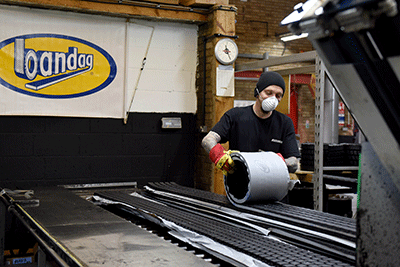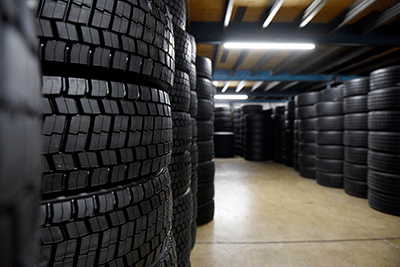
As the world’s largest new tyre manufacturer, turning over $28bn (£22bn) a year, it might seem surprising that Bridgestone also has a significant retread operation. It purchased global cold cure retread franchise Bandag, largely for its huge US operation, and acquired UK hot cure specialist Bulldog in Bourne, Lincolnshire.
The fortunes of truck tyre retreaders have waxed and waned in the past decade as a period of high prices and shortages of new tyres prior to 2011 has since been followed by a fall in new tyre prices and a wave of cheap Chinese imports.
In 2011, John Folliss, sales and marketing director for Bridgestone Europe north region, told MT: “I don’t think as an operator you won’t be able to get tyres. But you may not be able to get the tyre you want and you may well be fitting retreads when you wanted to fit new.”
But the days of low rubber prices are coming to an end for UK operators, as the double whammy of a fall in the pound following the Brexit vote and rising commodity prices will see tyre costs rise this year.
Terry Salter, retread business development manager for northern Europe at Bridgestone (pictured), says: “Since the peak of 2011 tyre prices have collapsed but that will change significantly soon. Falling raw materials prices had a big impact because they negated the advantage of retreads, and retread volumes have shrunk for the past four years.”

A return to rising new tyre prices will make retreads, which use only 20kg of raw materials compared with 65kg for a new tyre, more attractive on price. Bridgestone already has 90,000 vehicles owned by 65 fleets running on its retreads, and has recently added Royal Mail to its customer base.
“We had 100,000 vehicles on our retreads at the end of April,” Salter says. “This year will be the first year of growth in retread sales for five years as operators have turned away from Chinese tyres and returned to premium and retreads.”
Bridgestone is well placed to take advantage of any renaissance in retreads, having continued to invest heavily in the Bulldog factory while other manufacturers like Goodyear have pulled out of the UK retread market and Bandvulc has been sold to Continental.
“Bridgestone took the long view and continued to invest to cut costs,” says Salter. “We are committed to retreads and it is a core part of out Total Tyre Care strategy.”
Bulldog is highly unusual in that it makes both cold and hot cure retreads in the same hybrid factory. Its 50 staff make 80,000 tyres a year, split fairly equally between hot and cold cure. Around 70% of its output are truck tyres, the rest being bus tyres which have grown from around 10% of volumes in the past two years as Bridgestone has won more bus fleet business. While there a few common sizes between trucks and buses, most are specific for each application.

The collection of casings for retreading is outsourced to partners who make an initial assessment of the suitability of a worn out tyre for retreading. While Bulldog focuses on retreading Bridgestone and Firestone casings it will accept other premium products.
In theory there is no limit to the number of times a casing can be retreaded provided it is in good condition but in practice it is rare for a casing to be retreaded more than twice.
“In Scandinavia they will retread truck tyres five times, and aircraft tyres are retreaded up to 10 times,” says Salter. “But in the UK we would usually only retread tyres once or twice. The first retread is suitable for long haul and the second retread would go into more regional haul.”
Despite the recent resurgence in new tyre sales, Salter says it is “never easy” getting a good supply of high quality casings. This has been made harder since the arrival of Euro-6 trucks which use a 315/70 steer axle tyre that is a different size from drive and trailer tyres. “There is an over-supply of 315 tyres for retreading,” says Salter. “We need to find fleets that will use them.”
Bulldog makes 20 hot cure truck tyre retreads in seven different sizes from 17.5in to 22.5in wheel diameter. The Bandag cold cure process is much more flexible, and makes 85 different products in 38 sizes.

While a few operators such as refuse collection firms will fit retreaded steer tyres, most have a policy of only using new rubber on the front axle.
Finished tyres are taken to Coventry to be distributed by DHL Supply Chain to Bridgestone customers around the UK.
It does not export retreads as Bridgestone and Bandag have retreading operations on the continent.
Some like it hot
There are two types of retread – hot cure and cold or pre-cure – and each has its pros and cons.
At Bulldog, casings start out together, whether they are destined for hot or cold cure retreading. The tread is stripped away and the casing is visually inspected and any holes manually filled to prevent air bubbles forming during the retread process.
The casing is thoroughly inspected using a technique known as shearography, which involves taking a number of images of the casing and comparing them to detect structural weaknesses. Electrical probes also find any breakdown in the integrity of the casing.
The production process then splits and casings destined for hot cure have the sidewall stripped away. The strips of rubber compound that will form the new tread are wound onto the casing using a £500,000 machine and a fresh sidewall is applied by hand. The tyre is then cured in one of 15 presses that takes 90 minutes at 155C and 200psi to bond the new rubber to the casing and form the tread pattern.
No matter what make of casing was used, all hot cure retreads carry the Bridgestone Retread brand on the sidewall.
For cold cure, the casings have a layer of gum added before a ready-made strip of tread – cut precisely to length – is wound onto the casing. The ends are gummed and stapled together to secure the tread during the curing process, which takes four hours at 115C in large pressurised ovens that hold 20 tyres.

Labels are added to the sidewall to comply with regulations requiring tyres to indicate when and where they were made and if the load or speed rating has been changed. There is no requirement at the moment for retreads to carry the EU tyre labels for wet grip, noise and rolling resistance.
Shredded rubber generated in the recycling process fills two 1t bags every day. It is reused in a variety of applications such as all-weather football pitches and playgrounds because it is too contaminated to use for making tyres.
A finished hot cure tyre will always look better than a cold cure because its sidewalls have also been replaced with fresh rubber. But a cold cure tyre will last longer because its tread has been made under 2,000psi pressure and so its compound is denser and harder wearing than the hot cure equivalent which is under 200psi pressure when it is cured. Hot cure tyres can be regrooved whereas cold cure cannot.
For the manufacturer, hot cure needs a bigger investment in the factory and consistently large volumes whereas cold cure is a more flexible process that can cope with smaller volumes and changes in demand more easily. But a hot cure factory with enough volume can produce tyres cheaper than a cold cure process.
Bulldag? Bandog? A short history of Bridgstone retreads in the UK
1974 Bulldog starts up making hot cure retreads in Sleaford.
2005 Bridgestone purchases Bulldog to make hot cure retreads under Bulldog and Bridgestone brands.
2006 Bridgestone spends $1bn on global cold cure specialist Bandag, with 900 franchisees worldwide, 120 of which are in Europe. Bulldog becomes Bandag franchisee, the biggest of six owned by Bridgestone in the UK.
2016 Bridgestone invests £250,000 in latest Bandag extruder tyre builder.














